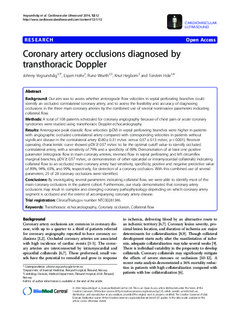| dc.contributor.author | Vegsundvåg, Johnny Åge | |
| dc.contributor.author | Holte, Espen | |
| dc.contributor.author | Wiseth, Rune | |
| dc.contributor.author | Hegbom, Knut | |
| dc.contributor.author | Hole, Torstein | |
| dc.date.accessioned | 2019-11-08T07:49:59Z | |
| dc.date.available | 2019-11-08T07:49:59Z | |
| dc.date.created | 2014-10-16T09:46:19Z | |
| dc.date.issued | 2014 | |
| dc.identifier.issn | 1476-7120 | |
| dc.identifier.uri | http://hdl.handle.net/11250/2627284 | |
| dc.description.abstract | Background
Our aim was to assess whether anterograde flow velocities in septal perforating branches could identify an occluded contralateral coronary artery, and to assess the feasibility and accuracy of diagnosing occlusions in the three main coronary arteries by the combined use of several noninvasive parameters indicating collateral flow.
Methods
A total of 108 patients scheduled for coronary angiography because of chest pain or acute coronary syndromes were studied using transthoracic Doppler echocardiography.
Results
Anterograde peak diastolic flow velocities (pDV) in septal perforating branches were higher in patients with angiographic occluded contralateral artery compared with corresponding velocities in patients without significant disease in the contralateral artery (0.80 ± 0.31 m/sec versus 0.37 ± 0.13 m/sec, p < 0.001). Receiver operating characteristic curve showed pDV ≥ 0.57 m/sec to be the optimal cutoff value to identify occluded contralateral artery, with a sensitivity of 79% and a specificity of 69%. Demonstration of at least one positive parameter (retrograde flow in main coronary arteries, reversed flow in septal perforating and left circumflex marginal branches, pDV ≥ 0.57 m/sec, or demonstration of other epicardial or intramyocardial collaterals) indicating collateral flow to an occluded main coronary artery had sensitivity, specificity, positive and negative predictive value of 89%, 94%, 63%, and 99%, respectively, for detection of a coronary occlusion. With this combined use of several parameters, 25 of 28 coronary occlusions were identified.
Conclusions
By investigating several parameters indicating collateral flow, we were able to identify most of the main coronary occlusions in the patient cohort. Furthermore, our study demonstrated that coronary artery occlusions may result in complex and diverging coronary pathophysiology depending on which coronary artery segment is occluded and the extent of accompanying coronary artery disease. | nb_NO |
| dc.language.iso | eng | nb_NO |
| dc.publisher | BMC (part of Springer Nature) | nb_NO |
| dc.rights | Navngivelse 4.0 Internasjonal | * |
| dc.rights.uri | http://creativecommons.org/licenses/by/4.0/deed.no | * |
| dc.title | Coronary artery occlusions diagnosed by transthoracic Doppler | nb_NO |
| dc.type | Journal article | nb_NO |
| dc.type | Peer reviewed | nb_NO |
| dc.description.version | publishedVersion | nb_NO |
| dc.source.volume | 12 | nb_NO |
| dc.source.journal | Cardiovascular Ultrasound | nb_NO |
| dc.source.issue | 1 | nb_NO |
| dc.identifier.doi | 10.1186/1476-7120-12-12 | |
| dc.identifier.cristin | 1164409 | |
| dc.description.localcode | © 2014 Vegsundvåg et al.; licensee BioMed Central Ltd. This is an Open Access article distributed under the terms of the Creative Commons Attribution License (http://creativecommons.org/licenses/by/2.0), which permits unrestricted use, distribution, and reproduction in any medium, provided the original work is properly credited. The Creative Commons Public Domain Dedication waiver (http://creativecommons.org/publicdomain/zero/1.0/) applies to the data made available in this article, unless otherwise stated. | nb_NO |
| cristin.unitcode | 194,65,25,0 | |
| cristin.unitcode | 1920,6,0,0 | |
| cristin.unitcode | 194,65,15,0 | |
| cristin.unitname | Institutt for sirkulasjon og bildediagnostikk | |
| cristin.unitname | Klinikk for hjertemedisin | |
| cristin.unitname | Institutt for klinisk og molekylær medisin | |
| cristin.ispublished | true | |
| cristin.fulltext | original | |
| cristin.qualitycode | 1 | |

